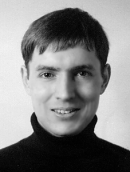The project
Mechanisms of neuronal interactions and their cognitive top-down control.
Winner

Dr Pascal Fries
F.C. Donders Centre for Cognitive Neuroimaging
Raboud University Nijmegen
Kapittelweg 29
6525 EN Nijmegen
The Netherlands
http://www.ru.nl/fcdonders/
Thirty-four year old Pascal Fries runs his own research group in The Netherlands since 2001 – an achievement in its own right for one so young. Several of his publications had major impact on the field (one has been cited 332 times in just five years) and some have appeared in Science and Nature. His doctorate thesis at the Johann Wolfgang Goethe-University won the ‘Best thesis of the year’ award. He graduated as a Medical Doctor from the same institution in 1998.
Dr Fries said: “The whole is often more than the sum of its parts. This holds for the brain more than for any other physical system we know. The reason for this is that the brain’s billions of cells interact. And they do this in a way that is certainly complex and hardly understood. This EURYI project will bring us closer to understanding how brain cells interact and how their interactions are dynamically modulated during cognitive operations.”
Provisional Award
€ 1,250,000
Project Description
Understanding our brain is one of the most important scientific challenges. It promises breakthroughs in information technology and it is required to move medicine towards insights into brain related diseases and to their causal therapies. And it is a metascientific endeavour that brings us closer to understanding how we understand.
Brain research has demonstrated a surprising dynamic of neuronal activation. Local groups of neurons fire rhythmically and distant groups synchronize their rhythms. There would certainly be no such synchronization without neuronal interaction. I propose that there would also be no neuronal interaction without synchronization. And this is the central hypothesis of this project: The rhythmic activation of local neuronal groups provides temporal windows for neuronal interaction. Connected groups interact when their rhythms are synchronized. Desynchronization prohibits interaction.
Thus, the dynamic of rhythmic neuronal synchronization might have mechanistic consequences for neuronal interactions and cognitive top-down control might direct neuronal interactions through organising the pattern of synchronization. We will investigate whether brain wide interaction networks activated during the performance of cognitive tasks are indeed integrated through rhythmic synchronization. And we will manipulate rhythmic synchronization both locally and between distant sites and probe the putative causal role of rhythmic synchronization for neuronal interaction and ultimately behaviour.

